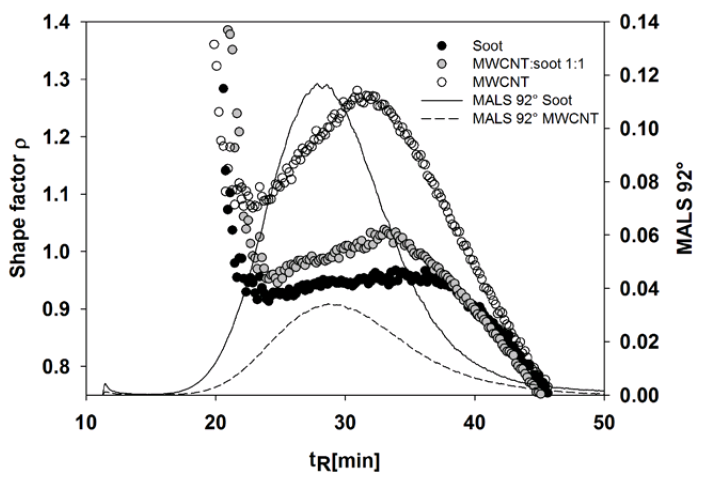Alexander Gogos (a,c), Ralf Kaegi (b), Renato Zenobi (c), Thomas D. Bucheli (a)
(a) Agroscope, 8046 Zürich, CH; (b) EAWAG, 8600 Dübendorf, CH; (c) ETH Zürich, Department of Chemistry and Applied Biosciences, 8093 Zürich, CH
Introduction
Methods to characterize and quantify Multi-Walled Carbon Nanotubes (MWCNTs) from soil samples are still scarcely available to date. Quantification – depending on the used method – may be biased by soot ubiquitously present in soils and sediments. Differentiating between MWCNTs and soot is a big challenge as they are physically and chemically very similar, e.g. in terms of thermal stability or density. Shape could however be a contrasting parameter for the detection of MWCNTs in pure soot or even soil. Therefore, we evaluated a shape factor ρ, derived from AF4-MALS measurements, for its capabilities to detect MWCNTs in these matrices [1].
Detection of MWCNTs in Soot
We used differently shaped particles (MWCNTs, soot, native soil particles) to depict the shape differentiation capabilities of AF4-MALS. The method used shall be addressed briefly: samples (particle powder, dry soil) were dispersed in 2 % Sodium deoxycholate/0.05% Sodium azide, sonicated and centrifuged at 17.500 g for 10 min. The supernatant half of the volume was then used as a working suspension. As an AF4 carrier, 10-5 M Ammonium nitrate/0.02% Sodium azide was used. For determination of the hydrodynamic radius (rh) we used retention time calibration with different certified latex standards. The radius of gyration (rg) was determined using the PN3621 21-angle MALS detector. Both parameters were combined to give a shape factor ρ = rg/rh Soot showed a relatively homogeneous ρ-distribution over the peak area (Fig.1) with average values of approx. 0.9. This was expected as the soot dispersions consisted of fractal-like aggregates that deviated from spherical shape (ρ > 0.775). Once MWCNTs were added, ρ showed an increase that was concentration dependent. These results could be confirmed using automated electron microscopy and image analysis (see Gogos et al. 2014).
Detection of MWCNTs in Soil
Native soil showed ρ-distributions comparable to soot (approx. 0.9, Fig. 2). Again, addition of MWCNT increased the resulting ρ values in a concentration dependent manner. Resulting method detection limits for MWCNTs in soils were in the order of 1.6 to 4 mg g-1.
Conclusion
- Generation of a shape factor ρ from rg and rh values over time enables differentiation of MWCNTs and soot.
- Shape factor increment is dependent on the ratio between MWCNTs and soot in a mixture, i.e. ρ is concentration dependent.
- Soil particles extracted by the presented method are contrasting to MWCNTs in terms of ρ, allowing specific detection of MWCNTs in these complex matrices.
- Detection limits are still much higher than any currently predicted environmental concentration.
References
[1] Gogos, A., Kaegi, R., Zenobi, R. and Bucheli, T. D., Environmental Science: Nano, 2014, 6(1), 584-594.



